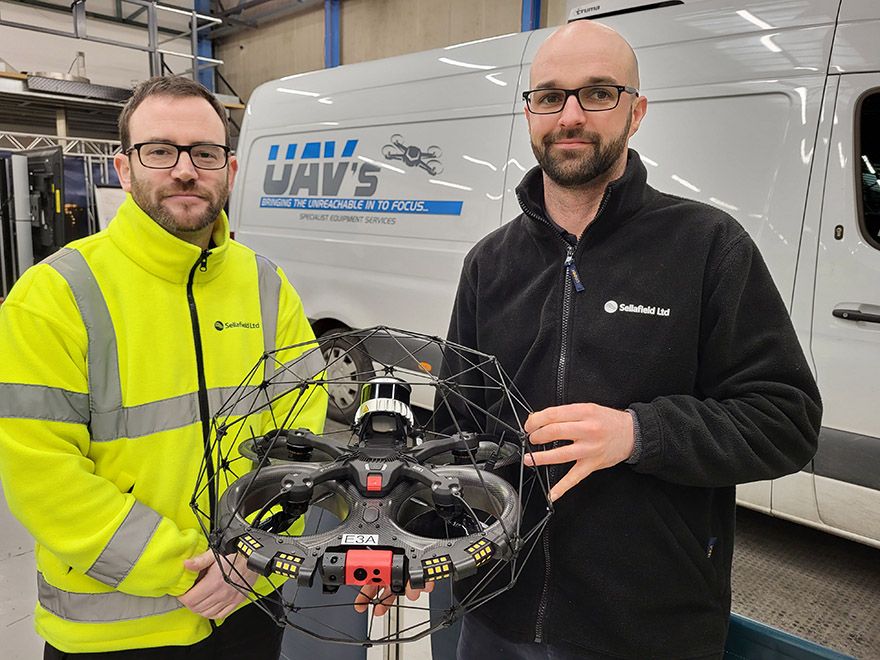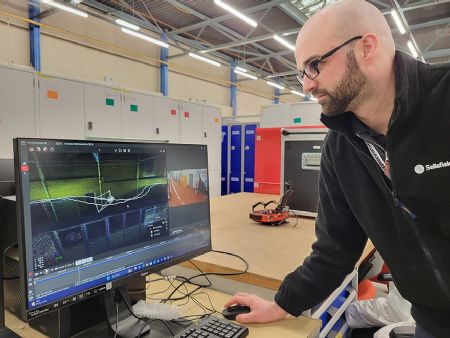 From left: Peter King, technical specialist and Sam Jay, UAV engineer and chief pilot, at Sellafield Ltd’s Engineering Centre of Excellence, with the Flyability Elios 3 drone
From left: Peter King, technical specialist and Sam Jay, UAV engineer and chief pilot, at Sellafield Ltd’s Engineering Centre of Excellence, with the Flyability Elios 3 droneThe successful deployment of an Elios 3 drone equipped with a LiDAR sensor at Sellafield marks a major milestone for the site’s Unmanned Aerial Vehicle (UAV) team, enabling
Sellafield Ltd to achieve unparalleled efficiency in mapping and 3-D modelling.
Hot on the heels of this first flight, the team then successfully flew the Elios 3 drone with a Radiation Activity Detection (RAD) dosimeter which they hope will allow them to map radiation hotspots before workers enter unused areas of the site.
Amanda Smith, UAV equipment programme lead, based at Sellafield Ltd’s Engineering Centre of Excellence in Cleator Moor, highlighted the safety and financial benefits of deploying a drone for the mapping. She said: “We are thrilled that this first flight of Elios 3 with the LiDAR payload was a success and the data collected is now being processed in a computer-aided design system which will produce a 3-D model of the area in question, helping to inform engineering decisions in the future.
“Sending a drone into this tight and unused space rather than an employee in the first instance reduces risk, and also saves time and money. The team put a lot of work into making sure they were fully prepared for this flight using building plans that they studied and used to work out the best route for the drone to take.
“However, these plans are decades old and, as in this case, the pilot encountered obstacles we were not expecting. The access into the area was also tighter than expected. He had to adapt to the changing circumstances incredibly quickly as he only had 8min of battery power to get into the area, map it with the equipment, and get out again. We always have two pilots on every flight as even though it is a short flight the levels of concentration required by the pilot are extremely high and at Sellafield we want to ensure the safety of both our pilots and the equipment.”
A lot of pressureSam Jay, UAV equipment engineer and chief pilot, said: “The flights can be very intense and in this case there was pipework everywhere. The drones fly in a cage with sensors so if they do happen to touch anything they will not be damaged. The hardest part is remembering your way out again. In such a short space of time you need to get in and out quickly. There can be a lot of pressure as not getting the drone out and having to send someone in after it would defeat the point of the flight.
“Now that we have scanned the area the engineers can design scaffolding before they go to unblock a pipe which has been causing an issue in this particular area. By deploying the drone, and speeding up the process we have potentially saved the company, and the taxpayer, hundreds of thousands of pounds.”
 Pictured right: Sam Jay, UAV engineer and chief pilot at Sellafield Ltd’s Engineering Centre of Excellence, looking at the screen display of the mapping images captured by the Flyability Elios 3 drone
Pictured right: Sam Jay, UAV engineer and chief pilot at Sellafield Ltd’s Engineering Centre of Excellence, looking at the screen display of the mapping images captured by the Flyability Elios 3 droneBuoyed by the success of this flight, Sellafield made history again this month as the first UK nuclear site to employ a drone equipped with a radiation monitor. This innovative addition aims to assess radiation levels and identify potential hotspots in areas where radiation exposure levels are unknown.
Tom Calverley, a radiometric physicist seconded to the UAV team, said: “The first flight was a great success but there are many safety checks to go through before we can rely on the data we obtain. We must ensure that the readings are accurate and once we have confidence in the numbers from the dose readings it can help with planning jobs and other radiation monitoring applications. We take exposure to radiation extremely seriously on the site and we carefully plan and minimise any exposure that colleagues may face as part of their job.
“Our acceptable levels of exposure are well below what the regulators say is safe. What we hope the drones will do is pinpoint any changes in dose readings within an area. If there are significant changes we can then explore why that might be. There is significant testing to do before we can have confidence in the readings. We are going to be testing the drone in a controlled environment by exposing it to varying dose profiles.
He concluded: “This testing will give us confidence in our understanding of the radiometric performance of the combined system. We must validate what manufacturers tell us as employee safety is our number one priority. But this is undoubtedly a huge step forward and could make a massive difference to how we operate and keep our staff safe on site.”